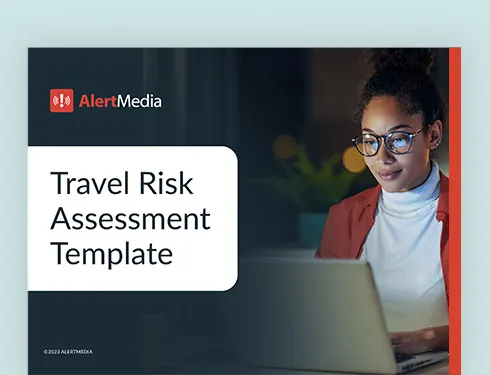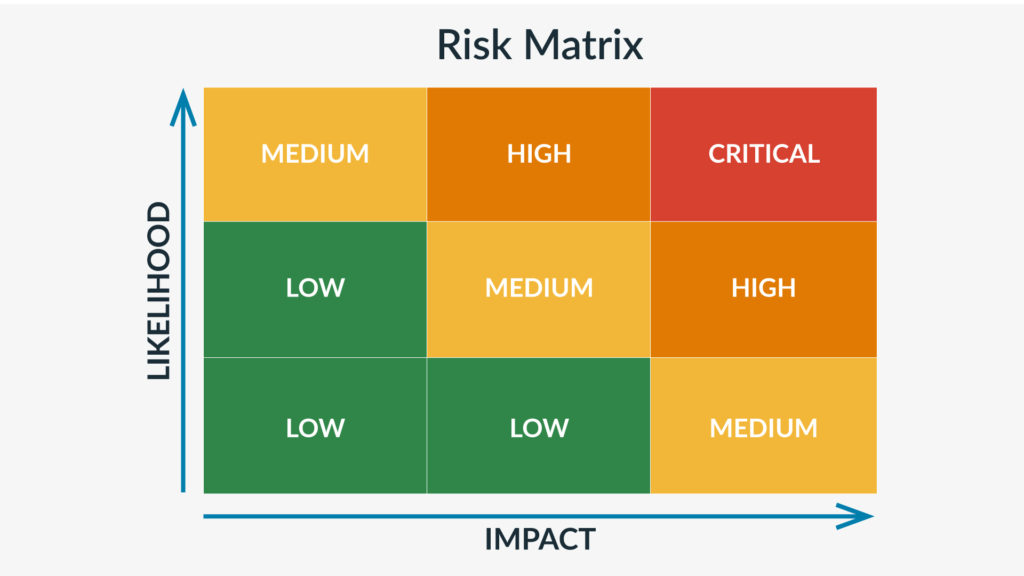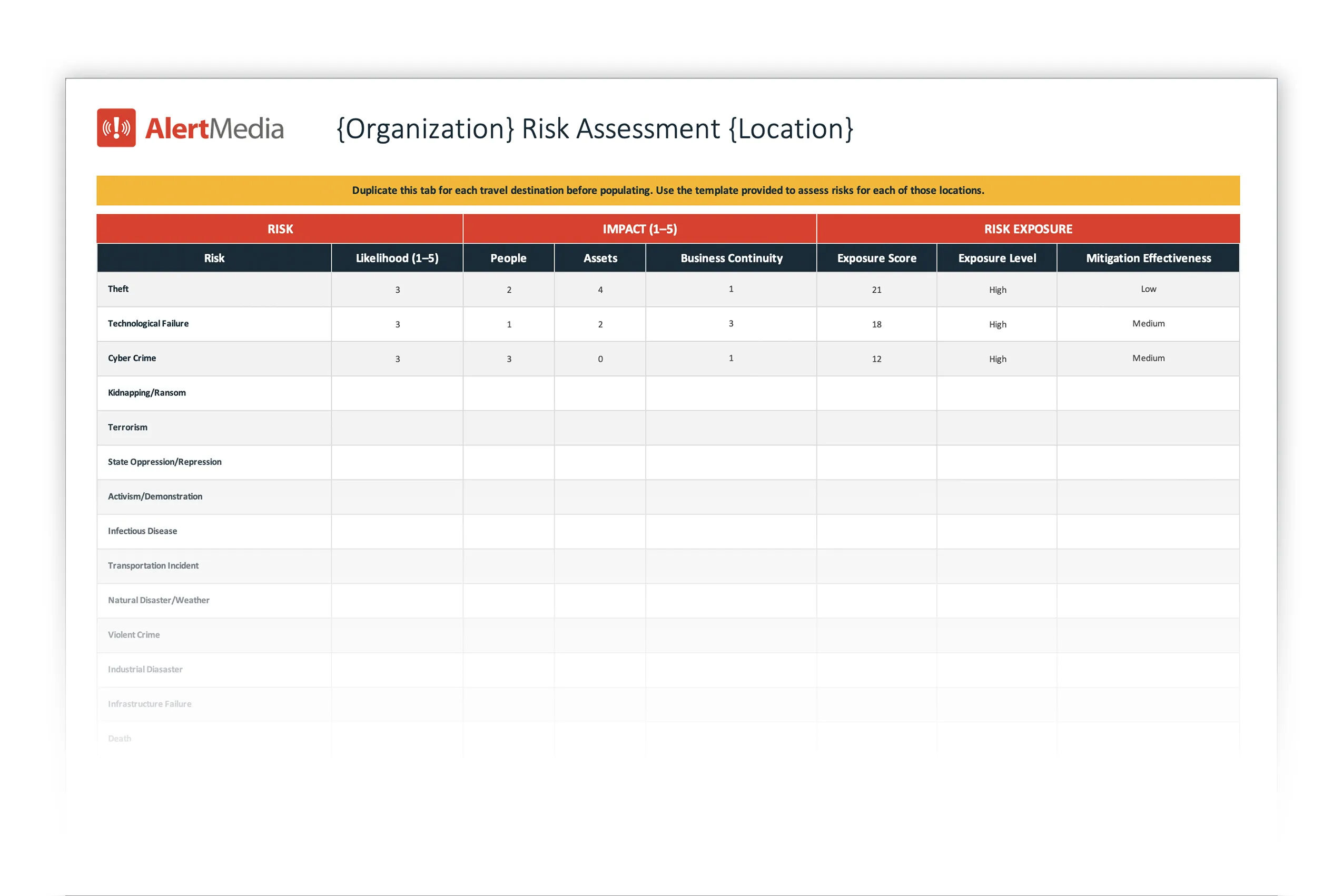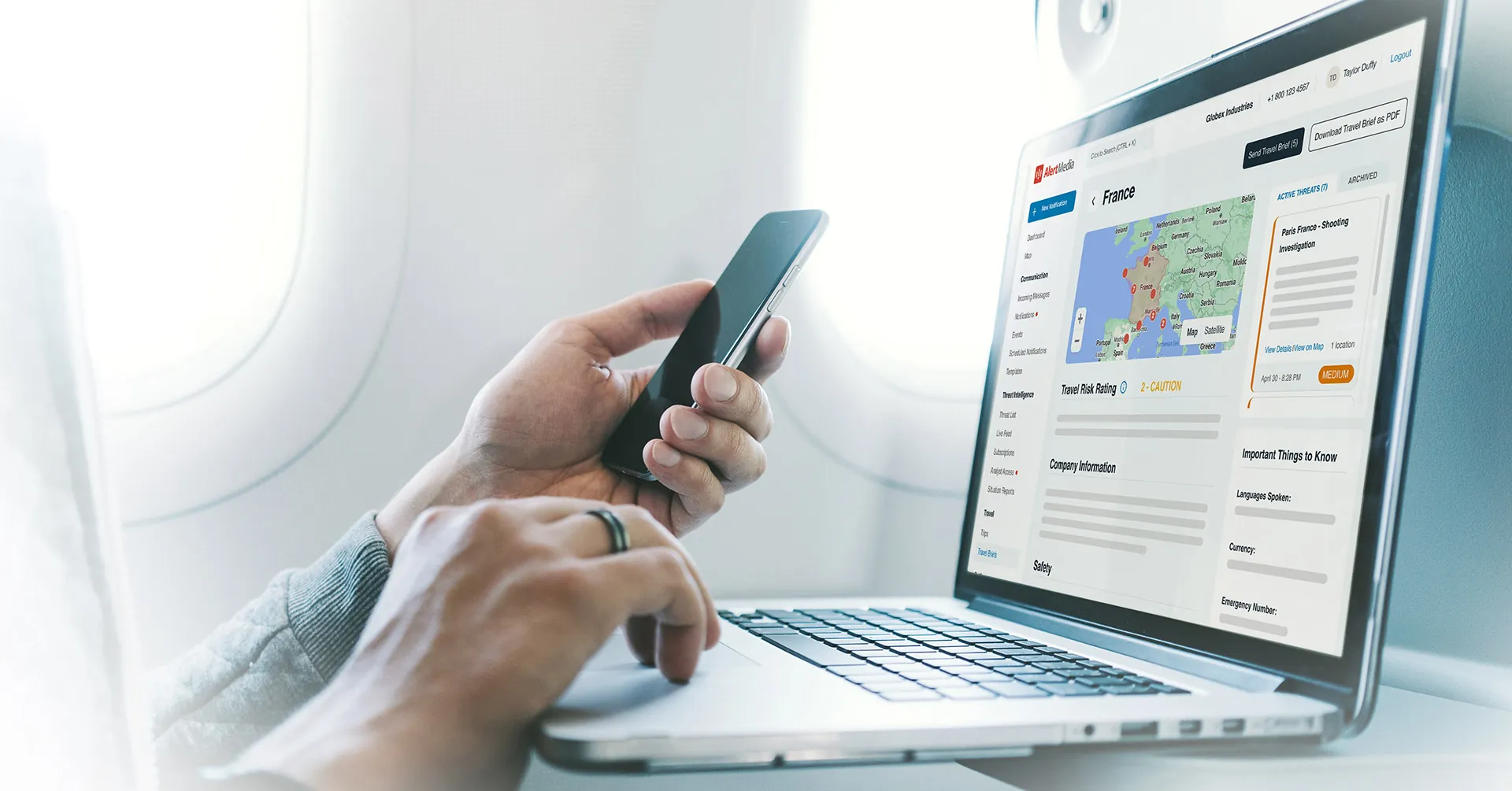
Business Travel Risk Assessment Examples & Template
Risk assessment for business travel is essential for keeping employees safe on the go. Learn how to identify, evaluate, and manage travel risks with practical examples and a proven assessment template.

According to the GBTA 2024 Business Travel Index Outlook report, travel spending is expected to surpass $2.0 trillion by 2028. And over 80% of surveyed business travelers reported that business travel is worthwhile for achieving corporate objectives. But protecting these employees on the road can be complicated. Business trips often introduce threats to employee health and safety despite the valuable business opportunities.
Travel managers aren’t the only ones concerned about safety away from home. Our State of Employee Safety Report found that safety is a top concern for business travelers, ranking second only to travel delays and disruptions. Less than half (40%) of travelers reported feeling extremely safe when traveling for work.

Investing in travel insurance and providing a robust travel policy are great ways to help fulfill your duty of care and keep your employees safe. Still, these are only the start of an effective travel risk management program.
Using a travel risk assessment template is a great way to determine your travel risks at scale, even with a small security team, high travel demands, and multiple travel destinations. This article will walk you through how to perform a business trip risk assessment using a template (you can download one for free here) so you can focus less on documentation and more on protecting those employees on the road. Throughout this article, you’ll find practical examples demonstrating how organizations perform real travel risk assessments.
Download Our Travel Risk Assessment Template
The Minnesota Twins Major League Baseball (MLB) team hosts an average of 2 million fans each year at Target Field, their home stadium in downtown Minneapolis. In addition to baseball games, the 38,000-capacity Target Field also hosts a wide range of events, including concerts, conventions, and community events throughout the year—all of which require a robust solution to ensure the safety of everyone involved. But even when the MLB team is far from home, they need a way to stay aware of threats.
Jeff Beahen, Senior Director of Security for the Minnesota Twins, uses AlertMedia’s live location-based safety alerts to inform the security team of emerging threats that may impact staff or players. “Knowing what’s occurring in our stadium on a non-game day is great—but that’s not where my players and staff are,” says Beahen. “We need real-time, relevant data for Miami, New York, Chicago, Detroit, or anywhere else the team is playing. Access to that intelligence is one of the greatest benefits of AlertMedia for our organization.”
When You Do (and Don’t) Need a Travel Risk Assessment
Any time your employees travel, there will be some risk—be it a risk of travel delays or disruptions or more extreme risks like kidnapping, terrorism, or natural disasters. But depending on your travel demands and locations, your safety needs will vary.
If your company is based in Cincinnati and you primarily have remote employees from across the Midwest traveling to in-office events twice a year, you’ll likely need a less complicated risk assessment form than a company sending its C-suite executives to London, Mexico City, Hong Kong, and other international cities every other month.
Pre-authorizing travel destinations
Some businesses use the travel risk management strategy of creating lists of travel destinations and categorizing them ahead of time based on their overall business travel risk level. Delia Midamba, Head of Physical Security at Cloudflare, explained the process her team uses to ensure they have properly assessed their risks for travel requests.
“We take a couple of different approaches. The first is an ‘allow’ list. Those are the countries where if you’re going to work there for less than 20 days, don’t ask us, you’re fine. Just go ahead and go. We’ve evaluated the security risk. We’ve evaluated the tax implications. And we’ve said if it’s less than 20 days, have fun. Then there are the countries that are not on the allow list. That, at least, has allowed us to whittle down how much research we have to do when an employee reaches out. But when they do reach out, we have to check: What are the safety implications? What are the cybersecurity implications? And then come to a determination on whether the employee can go and what precautions we need to put in place for them to be able to.”
—Delia Midamba, Head of Physical Security at Cloudflare
Performing assessments ahead of time for frequent travel destinations means you don’t have to scramble when a trip request lands on your desk. The more complicated your travel situation, the more beneficial a risk assessment is. From those assessments, it’s easy to create lists of travel destinations that are automatically approved from a safety standpoint—as Delia does at Cloudflare—that you can direct employees to when they are looking into travel.
Understanding Travel Risk: Definition and Scope
What is travel risk?
Travel risk refers to the broad spectrum of potential threats—ranging from minor disruptions like flight delays or lost luggage to significant hazards such as terrorism, natural disasters, or serious illness—that travelers may encounter during business trips.
How travel risk varies
Travel risk is never uniform. It varies greatly depending on both the traveler’s individual characteristics—such as gender, health status, role within the organization, and personal circumstances—and the unique attributes of each travel destination, including political stability, cultural norms, infrastructure quality, and local laws and customs.
Why understanding travel risk matters
Clearly understanding and evaluating these risks is critical for ensuring the safety and well-being of your traveling employees. A proactive, tailored approach to travel risk assessment not only protects your travelers but also helps sustain operational continuity and safeguards your organization’s reputation and responsibilities.
Going beyond a risk matrix
A risk matrix (shown below) is a helpful tool for taking a high-level view of risk, but it doesn’t always allow for the level of granularity that travel risk assessments require. When looking at safety in complicated situations like travel, especially when assessing risk at scale for a larger organization, it’s helpful to have a tool that can accommodate all the information you’ll need to document.

A more robust template like this one, which you can download for free, is a more streamlined way to ensure you know what to prepare your organization for and inform your employees about when they are traveling.
Why Use a Risk Assessment Template
For a risk assessment to be the most useful to your business, you need a clear understanding of a location’s possible threats, the likelihood of those threats impacting your travelers, and an estimation of how the risk would affect your business. It’s also helpful to compare high- and low-risk locations and to compare risk scores to previous assessment forms—to see if locations are growing more or less dangerous over time.
 Preview of Travel Risk Assessment Template
Preview of Travel Risk Assessment TemplatePreliminary Research and Information Gathering
Before diving into a detailed travel risk assessment, it’s essential to conduct thorough preliminary research about the destination and surrounding factors. This initial phase lays the groundwork for effective risk identification, evaluation, and mitigation, ensuring your organization fully understands the environment your travelers will encounter.
Here’s how to approach this vital research stage:
1. Gather comprehensive, current destination information
Begin by compiling the latest information about each travel destination, covering areas like:
- Political stability and ongoing conflicts
- Cultural and societal norms impacting traveler safety
- Public health advisories (such as disease outbreaks or vaccination requirements)
- Recent safety alerts, crime statistics, and infrastructure reliability
2. Utilize authoritative sources
Make sure your research relies on trustworthy, authoritative resources, such as:
- Government travel advisories (e.g., U.S. State Department, U.K. Foreign Office)
- Public health databases (e.g., CDC, WHO)
- Reliable local and international news reports
- Historical incident logs or internal travel reports maintained by your organization
3. Tailor research to traveler context
Remember that effective research is always context-specific. Tailor your information-gathering efforts based on:
- The nature of the trip (short-term travel vs. extended stays, urban vs. rural locations, etc.)
- Traveler profiles (executives, LGBTQ+ employees, employees with medical conditions, etc.)
- Unique, destination-specific risks that might disproportionately impact certain individuals or groups
4. Monitor current events and real-time intelligence
Risk landscapes change rapidly. Stay agile by regularly monitoring current events and leveraging real-time threat intelligence platforms. Tools that offer location-based risk alerts, threat history databases, and predictive analytics can dramatically improve your research accuracy and responsiveness.
5. Document research findings systematically
Ensure that every detail gathered during preliminary research is documented clearly and systematically. Doing so not only promotes transparency but also makes future assessments repeatable, efficient, and continuously improving.
By investing in structured preliminary research, your organization establishes a solid foundation for accurate and actionable travel risk assessments, ultimately strengthening your ability to protect traveling employees wherever their journeys take them.
How to Perform a Business Travel Risk Assessment
The travel risk assessment process has six steps, whether you’re using a template or documenting it in some other way. Here’s what it looks like.
1. Determine your travel destinations
To know the risks of your travel plans, you must know where you’re going. Are your employees primarily traveling between facilities in the contiguous United States? Do you have frequent international travel to other business partners? Create a list of places where your team might travel.
Suppose you have remote/nomadic workers or employees planning to work from locations other than their homes for extended periods. In that case, you may consider adding these locations to your risk assessments. Your duty of care obligations also extend to protecting these employees, and there may be higher risks than the employees are aware of.
Practical example: If your employees frequently travel to manufacturing facilities in coastal Florida, you’ll need to prioritize risks like hurricanes and flooding. Conversely, travel to business hubs like Tokyo might prompt a deeper review of earthquake preparedness.

2. Research potential risks in those locations
Figuring out what risks your employees might face can seem intimidating, but plenty of resources are available to get you started. The U.S. State Department publishes travel advisories with significant threats and any travel warnings or more extensive travel restrictions in different countries. You can also look through public databases of crime rates, civil unrest, and public health emergencies. If you have a log of past incidents, you can also use those as examples.
The specific potential travel risks you find will vary depending on where your employees are traveling and any increased risk factors those employees will have. There may be some locations where high-level executives face an increased risk of kidnapping, and there are areas where LGBTQ+ employees will be at a higher risk for harassment and detention. Here are a few examples of potential threats to consider in your travel destinations:
- Terrorism
- Public health risks/infectious diseases
- Political unrest
- Crime/theft
- Civil unrest/demonstrations
- Extreme weather/natural disasters
- Travel disruptions
- Infrastructure failures
- Medical emergency
- Cyberattack
- Kidnapping/ransom
Practical example: A business traveler visiting Johannesburg might face heightened risks of street crime and theft, prompting special safety briefings. Meanwhile, a team heading to rural regions in Southeast Asia might require increased awareness about infectious diseases and limited healthcare infrastructure.
If you have access to a threat intelligence system, especially one with a threat history feature that shows past events in each area, this process will be more accurate and more accessible. Whether you’re pulling up threat history through your intelligence system or reviewing public advisories and incident logs, your travel risk management will benefit from this knowledge.
3. Determine the likelihood of those risks
“Wherever we go, we're armed with live threat intelligence at our fingertips. Whether navigating around road closures or bracing for severe weather, having timely and pertinent information about potential hazards gives us a leg up on our response.”Charles Adams Director of Security, The Minnesota Twins
To adequately prioritize and prepare for these risks, you need to know how likely they will happen. When estimating the potential likelihood of these risks in any given location, you may consider whether your company has faced the threat before, whether your employees are part of a frequently targeted group, whether the location is experiencing destabilization, and whether there are any trend lines in these threats that might indicate a rise in the rate of incidence.
Practical example: Consider executives traveling to cities experiencing recent political demonstrations. While civil unrest may typically be low risk, recent protests could significantly increase the likelihood, prompting enhanced real-time monitoring and communication.
It can also be helpful to consider if there are any employees with additional factors that might put them at high risk. Some risk factors might be employees with disabilities or medical conditions, women, LGBTQ+ employees, and religious or ethnic minorities.
4. Estimate the impact of those risks
Next, you’ll determine what the impact of those risks might be if they were to occur. An easy way to break this down into something more actionable is to assess the impact of a given risk on these three facets:
- People—Will this harm your employees?
- Assets—Is company-owned technology or IP in harm’s way?
- Business continuity—How much will this disrupt your business operations?
Practical example: An IT specialist traveling internationally with sensitive data might face an exceptionally high impact from cyber theft, potentially causing serious harm to company operations. Mitigation might include encrypted devices and secure connectivity tools.
You can rank impacts within these three categories to create a numerical impact value. This will help you later if you are using an equation to calculate exposure, and it also gives you a high-level way to compare different risks and locations.
5. Calculate your exposure level
Factor the likelihood and impact of a given risk factor into your overall risk exposure score. You can use your exposure level to understand any particularly significant hazards better. You can also use your exposure level to determine if your mitigation efforts are practical. For example, suppose your exposure level to infectious disease is exceptionally high, and you don’t have any mitigation or control measures, such as vaccination requirements. In that case, you now have a place to start for improving travel safety.
Practical example: A sales representative heading to regions with elevated infectious disease exposure, like areas experiencing dengue outbreaks, might have a higher exposure score, highlighting the need for preventive measures like vaccinations, insect repellent, and comprehensive health briefings.
Pro tip: ISO 31030 provides a comprehensive framework for travel risk management (TRM) to help companies manage these concerns.
6. Reassess at regular intervals
Like any other risk, travel risks change over time. Many factors can change your destination’s risk rating, so the best way to keep up with any real-time changes is to create a regular cadence for reviewing and revising your travel risk assessment.
Practical example: For instance, a previously low-risk location like Paris might shift to moderate risk due to recent terrorist incidents or sustained civil unrest, prompting updates to your assessments and mitigation steps.
Example: Travel Risk Assessment for Executive Travel to Mexico City
Below is a practical example demonstrating how a business might perform a travel risk assessment for a senior executive attending meetings in Mexico City:
Risk Factor | Likelihood | Impact | Exposure Level | Mitigation Measures |
| Street crime & theft | High | Medium | High | Secure transportation arrangements, hotel safety briefing, avoid high-risk neighborhoods |
| Kidnapping | Medium | High | High | Executive protection detail, GPS tracking, established emergency protocol |
| Civil unrest | Medium | Medium | Medium | Daily intelligence briefings, SMS & messaging alerts for real-time updates |
| Medical emergency | Medium | High | High | Confirmed nearby medical facilities, comprehensive travel insurance, access to medical evacuation |
By systematically assessing these risks, the security team identified necessary controls such as dedicated transport, intelligence monitoring, and direct executive protection, significantly reducing the overall travel risk exposure for the executive.
Documentation and collaboration
Effective travel risk assessments rely heavily on structured documentation and proactive collaboration. By clearly documenting every step, decision, source, and update in your risk assessment process, you not only improve transparency but also ensure repeatability and continuous improvement over time. Good documentation means your organization can easily revisit past assessments to quickly address similar scenarios in the future without starting from scratch.
Moreover, collaboration between stakeholders—including security teams, HR, travel managers, executive leaders, and even the travelers themselves—is critical. Joint input from diverse perspectives ensures a more comprehensive and accurate assessment, builds trust, and creates stronger organizational buy-in, leading to smoother implementation and adherence.
Practical ways to enhance documentation and collaboration include:
- Utilizing shared digital platforms where all stakeholders can access and update travel risk information in real time
- Establishing regular feedback loops, such as monthly or quarterly meetings, to discuss assessments, address issues, and share lessons learned
- Providing user-friendly reporting mechanisms (e.g., mobile apps or web forms) for travelers to report real-time incidents or valuable safety observations during trips
Encouraging ongoing communication and systematically reviewing feedback from completed trips ensures your assessments remain dynamic and continuously improve, keeping your travel safety practices ahead of emerging threats.
Response and Support Capabilities: Key Elements to Include
Robust travel risk management doesn’t stop at assessing and communicating risks; organizations must also be ready with clear response and support capabilities to assist traveling employees when incidents occur. Here are the essential elements your response plan should include:
1. Emergency response plans
Documented, easy-to-follow emergency response plans are crucial. Travelers should know what actions to take and whom to contact during various incidents, such as medical emergencies, natural disasters, civil unrest, or crime. Plans should be accessible 24/7, ensuring help is never far away, regardless of the situation.
2. Support mechanisms and real-time assistance
Travelers need reliable and immediate access to support services. Whether this involves partnering with a dedicated response provider, a 24-hour operations center, or your internal crisis team, ensure that travelers have direct communication lines to real-time assistance, guidance, and support.
3. Communication protocols
Establish clear, reliable communication protocols for routine status checks and emergencies. Include multiple communication channels—such as SMS, voice calls, messaging apps like WhatsApp, and email—to guarantee that employees can connect with support even if some methods become unavailable.
4. Emergency contacts and resources
Provide travelers with comprehensive emergency contact lists, including local authorities, embassies, hospitals, and internal organizational points of contact. Make this list accessible digitally (e.g., via mobile apps) and physically (e.g., printed emergency cards), ensuring quick reference during stressful situations.
5. Continuous monitoring and feedback
Implement ongoing risk monitoring, ensuring your organization can proactively respond to emerging threats. Additionally, maintain accessible reporting channels for travelers to promptly report incidents or seek assistance, enabling swift interventions and helping your organization continually improve its response and support strategies.
By including these key capabilities, your travel risk management program will anticipate potential emergencies and provide tangible, timely solutions to keep your people safe, no matter where they travel.
Communicating About Threats With Traveling Employees
Effective communication is fundamental to protecting travelers from risks, both before departure and throughout their journeys. Establishing clear communication procedures ensures travelers have the information they need when they need it, while empowering them to respond proactively if threats emerge.
Structured pre-trip briefings and ongoing updates
Begin by conducting structured pre-trip briefings explicitly tailored to each destination. These briefings should clearly outline potential risks, mitigation strategies, and essential details travelers must know before departure, such as:
- Local emergency numbers and resources
- Health advisories and precautions
- Cultural norms and legal considerations
- Recommended actions in case of specific incidents (e.g., natural disasters, civil unrest, medical emergencies)
Once travelers are en route or at their destination, maintain a system for ongoing communication, regularly providing timely updates about emerging threats, changes in local conditions, or incidents occurring nearby.
Multichannel communication strategies
Reliability requires redundancy. Travelers should always have access to critical updates through multiple communication channels. Consider implementing and training travelers to use various options, such as:
- SMS and mobile alerts
- Secure messaging platforms (e.g., WhatsApp, Signal)
- Email updates
- Phone calls via dedicated support lines
Ensure travelers clearly understand how and when to use each channel, especially in areas of low connectivity or restricted communications infrastructure.
Defined roles and responsibilities
Establish roles and responsibilities for sending, receiving, and escalating communications:
- Identify specific individuals or teams responsible for monitoring threats and issuing timely alerts.
- Define who within your organization is authorized to distribute critical information, who should receive it, and how urgent situations should be escalated to senior leadership.
- Clarify expectations for travelers, including responsibilities for acknowledging updates and responding to check-ins.
This clarity ensures accountability and eliminates confusion during high-pressure situations.
Two-way communication and feedback loops
Encourage two-way communication systems that allow travelers to receive alerts, provide real-time feedback, report incidents, or request immediate assistance. Two-way communication promotes rapid response, strengthens traveler confidence, and helps your organization continuously improve future risk communications through direct traveler feedback.
Leveraging technology for effective communication
Harness technology solutions—such as dedicated travel safety apps, integrated risk intelligence platforms, and automated notification systems—to centralize, streamline, and document all communication efforts. These tools allow for the efficient distribution of mass notifications and personalized updates tailored to each traveler’s circumstances. Leveraging such technology ensures that travelers consistently receive timely, relevant, and actionable risk information, significantly enhancing your organization’s overall travel safety posture.
Protecting Your Traveling Employees at Scale
In a world with an increasingly complicated threat landscape, travel safety is not something you want to leave up to chance. Performing a pre-travel risk assessment is one of the best ways to ensure that you can protect the health and safety of your team, no matter where they are in the world. Download this free template to get started. If you’re looking for an integrated system for protecting your travelers, click here to learn how AlertMedia’s Travel Risk Management is the best tool for understanding your corporate travel threats and staying in touch with your employees on the road, all in one streamlined system.
Download Our Travel Risk Assessment Template
More Articles You May Be Interested In
-
 Safety and Security, Emergency Management20 Business Travel Safety Tips and Guidelines for Employees
Safety and Security, Emergency Management20 Business Travel Safety Tips and Guidelines for Employees -
 Emergency Management, Safety and SecurityHow the ISO 31030 Framework Enhances Travel Safety and Business Resilience
Emergency Management, Safety and SecurityHow the ISO 31030 Framework Enhances Travel Safety and Business Resilience -
 Company NewsIntroducing Travel Risk Management: Protecting Traveling Employees 24/7
Company NewsIntroducing Travel Risk Management: Protecting Traveling Employees 24/7


